Microwave-Assisted Synthesis of Pt/SnO2 for the Catalytic Reduction of 4-Nitrophenol to 4-Aminophenol
Abstract
:1. Introduction
2. Materials and Methods
2.1. Chemicals
2.2. Stock Solution Preparation
2.3. Synthesis of the Samples
2.4. Instrumental Analysis
2.5. Catalytic Measurements
3. Results
3.1. XRD Results
3.2. FE SEM Results
3.3. STEM Results
3.4. BET Nitrogen Adsorption–Desorption Isotherm and Pore Volume
3.5. XPS Results
3.6. Mössbauer Spectroscopy
3.7. Catalytic Measurements
4. Discussion
5. Conclusions
Supplementary Materials
Author Contributions
Funding
Informed Consent Statement
Data Availability Statement
Conflicts of Interest
References
- Chen, W.; Cao, J.; Yang, J.; Cao, Y.; Zhang, H.; Jiang, Z.; Zhang, J.; Qian, G.; Zhou, X.; Chen, D.; et al. Molecular-level insights into the electronic effects in platinum-catalyzed carbon monoxide oxidation. Nat. Commun. 2021, 12, 6888. [Google Scholar] [CrossRef] [PubMed]
- Jeyaraj, M.; Gurunathan, S.; Qasim, M.; Kang, M.; Kim, J. A Comprehensive Review on the Synthesis, Characterization, and Biomedical Application of Platinum Nanoparticles. Nanomaterials 2019, 9, 1719. [Google Scholar] [CrossRef] [PubMed]
- Papandrew, A.B.; Chisholm, C.R.I.; Elgammal, R.A.; Özer, M.M.; Zecevic, S.K. Advanced Electrodes for Solid Acid Fuel Cells by Platinum Deposition on CsH2PO4. Chem. Mater. 2011, 23, 1659–1667. [Google Scholar] [CrossRef]
- Liu, D.; Li, X.; Chen, S.; Yan, H.; Wang, C.; Wu, C.; Haleem, Y.A.; Duan, S.; Lu, J.; Ge, B.; et al. Atomically dispersed platinum supported on curved carbon supports for efficient electrocatalytic hydrogen evolution. Nat. Energy 2019, 4, 512–518. [Google Scholar] [CrossRef]
- Haneda, M.; Watanabe, T.; Kamiuchi, N.; Ozawa, M. Effect of platinum dispersion on the catalytic activity of Pt/Al2O3 for the oxidation of carbon monoxide and propene. Appl. Catal. 2013, 142, 8–14. [Google Scholar] [CrossRef]
- Ponjavic, M.; Stevanovic, S.; Nikodinovic-Runic, J.; Jeremic, S.; Cosovic, V.R.; Maksimovic, V. Bacterial nanocellulose as green support of platinum nanoparticles for effective methanol oxidation. Int. J. Biol. Macromol. 2022, 223, 1474–1484. [Google Scholar] [CrossRef]
- Kostoglou, N.; Liao, C.; Wang, C.; Kondo, J.N.; Tampaxis, C.; Steriotis, T.; Giannakopoulos, K.; Kontos, A.G.; Hinder, S.; Baker, M.; et al. Effect of Pt nanoparticle decoration on the H2 storage performance of plasma-derived nanoporous graphene. Carbon 2021, 171, 294–305. [Google Scholar] [CrossRef]
- Rioux, R.M.; Song, H.; Hoefelmeyer, J.D.; Yang, P.; Somorjai, G.A. High-Surface-Area Catalyst Design: Synthesis, Characterization, and Reaction Studies of Platinum Nanoparticles in Mesoporous SBA-15 Silica. J. Phys. Chem. B 2005, 109, 2192–2202. [Google Scholar] [CrossRef]
- Bai, L.; Zhang, S.; Chen, Q.; Gao, C. Synthesis of Ultrasmall Platinum Nanoparticles on Polymer Nanoshells for Size-Dependent Catalytic Oxidation Reactions. ACS Appl. Mater. Interfaces 2017, 9, 9710–9717. [Google Scholar] [CrossRef]
- Elezovic, N.R.; Babic, B.M.; Radmilovic, V.R.; Krstajic, N.V. Synthesis and Characterization of Pt Catalysts on SnO2 Based Supports for Oxygen Reduction Reaction. J. Electrochem. Soc. 2013, 160, F1151. [Google Scholar] [CrossRef]
- Śmiechowicz, I.; Kocemba, I.; Rogowski, J.; Czupryn, K. CO oxidation over Pt/SnO2 catalysts. React. Kinet. Mech. Catal. 2018, 124, 633–649. [Google Scholar] [CrossRef]
- Martyla, A.; Kopczyk, M.; Marciniak, P.; Przekop, R. One-pot method of synthesis of Pt/SnO2 system and its electrocatalytic activity. Chem. Cent. J. 2014, 8, 49. [Google Scholar] [CrossRef] [PubMed]
- Hesse, R.; Chassé, T.; Szargan, R. Peak shape analysis of core level photoelectron spectra using UNIFIT for WINDOWS, Fresenius. J. Anal. Chem. 1999, 365, 48–54. [Google Scholar]
- Klencsár, Z.; Kuzmann, E.; Vértes, A. User-friendly software for Mössbauer spectrum analysis. J. Radioanal. Nucl. Chem. 1996, 210, 105–118. [Google Scholar] [CrossRef]
- Williamson, G.K.; Hall, W.H. X-ray line broadening from filed aluminium and wolfram. Acta Metall. 1953, 1, 22–31. [Google Scholar] [CrossRef]
- Štefanić, G.; Krehula, S.; Štefanić, I. The high impact of a milling atmosphere on steel contamination. Chem. Commun. 2013, 49, 9245–9247. [Google Scholar] [CrossRef]
- Cheary, R.W.; Coelho, A.A. A fundamental parameters approach to X-ray line-profile fitting. J. Appl. Cryst. 1992, 25, 109–121. [Google Scholar] [CrossRef]
- Marić, I.; Dražić, G.; Radin, E.; Peter, R.; Škrabić, M.; Jurkin, T.; Pustak, A.; Baran, N.; Mikac, L.; Ivanda, M.; et al. Impact of platinum loading and dispersion on the catalytic activity of Pt/SnO2 and Pt/α-Fe2O3. Appl. Surf. Sci. 2023, 607, 155073. [Google Scholar] [CrossRef]
- Indris, S.; Scheuermann, M.; Becker, S.M.; Sepelák, V.; Kruk, R.; Suffner, J.; Gyger, F.; Feldmann, C.; Ulrich, A.S.; Hahn, H. Local Structural Disorder and Relaxation in SnO2 Nanostructures Studied by 119Sn MAS NMR and 119Sn Mössbauer Spectroscopy. J. Phys. Chem. C 2011, 115, 6433–6437. [Google Scholar] [CrossRef]
- Radin, E.; Štefanić, G.; Dražić, G.; Marić, I.; Jurkin, T.; Pustak, A.; Baran, N.; Raić, M.; Gotić, M. Solid-state dispersions of platinum in the SnO2 and Fe2O3 nanomaterials. Nanomaterials 2021, 11, 3349. [Google Scholar] [CrossRef]
- Gotić, M.; Musić, S. Synthesis of Nanocrystalline Iron Oxide Particles in the Iron(III) Acetate/Alcohol/Acetic Acid System. J. Inorg. Chem. 2008, 6, 966–973. [Google Scholar] [CrossRef]
- Gotić, M.; Koščec, G.; Musić, S. Study of the reduction and reoxidation of substoichiometric magnetite. J. Mol. Struct. 2009, 924–926, 347–354. [Google Scholar] [CrossRef]
- Marić, I.; Dražić, G.; Štefanić, G.; Zadro, K.; Gotić, M.; Jurkin, T. Characterization of radiolytically synthesized feroxyhyte and oxidized magnetite nanoparticles. Mater. Charact. 2020, 159, 110038. [Google Scholar] [CrossRef]
- Gotić, M.; Ivanda, M.; Sekulić, A.; Musić, S.; Popović, S.; Turković, A.; Furić, K. Microstructure of nanosized TiO2 obtained by sol-gel synthesis. Mater. Lett. 1996, 28, 225–229. [Google Scholar] [CrossRef]
- Ivanda, M.; Musić, S.; Popović, S.; Gotić, M. XRD, Raman and FT-IR spectroscopic observations of nanosized TiO2 synthesized by the sol-gel method based on an esterification reaction. J. Mol. Struct. 1999, 481, 645–649. [Google Scholar] [CrossRef]
- Steinhauer, S.; Lackner, E.; Sosada-Ludwikowska, F.; Singh, V.; Krainer, J.; Wimmer-Teubenbacher, R.; Grammatikopoulos, P.; Köck, A.; Sowwan, M. Atomic-scale structure and chemical sensing application of ultrasmall size-selected Pt nanoparticles supported on SnO2. Mater. Adv. 2020, 1, 3200–3207. [Google Scholar] [CrossRef]
- Smirnov, M.Y.; Vovk, E.I.; Nartova, A.V.; Kalinkin, A.V.; Bukhtiyarov, V.I. An XPS and STM Study of Oxidized Platinum Particles Formed by the Interaction between Pt/HOPG with NO2. Kinet. Catal. 2018, 59, 653–662. [Google Scholar] [CrossRef]
- Smirnov, M.Y.; Vovk, E.I.; Kalinkin, A.V.; Simonov, P.A.; Gerasimov, E.Y.; Bukhtiyarov, V.I. Formation of Surface Platinum Oxides in the Interaction of the Pt/Sibunit Catalysts with NO2: Estimates of the Width of Oxide Shell from XPS Data. Kinet. Catal. 2018, 59, 663–671. [Google Scholar] [CrossRef]
- Kalinkin, A.V.; Smirnov, M.Y.; Bukhtiyarov, V.I. Oxidation of a Platinum Foil with Nitrogen Dioxide. Kinet. Catal. 2016, 57, 826–830. [Google Scholar] [CrossRef]
- Degler, D.; Pereira de Carvalho, H.W.; Kvashnina, K.; Grunwaldt, J.-D.; Weimar, U.; Barsan, N. Structure and chemistry of surface-doped Pt:SnO2 gas sensing materials. RSC Adv. 2016, 6, 28149–28155. [Google Scholar] [CrossRef]
- Marić, I.; Gotić, M.; Pustak, A.; Dražić, G.; Grenèche, J.-M.; Jurkin, T. Magnetic δ-FeOOH/Au nanostructures synthesized using γ-irradiation method and their catalytic activity for the reduction of 4-nitrophenol. Appl. Surf. Sci. 2023, 611, 155653. [Google Scholar] [CrossRef]
- Shultz, L.R.; Hu, L.; Preradovic, K.; Beazley, M.J.; Feng, X.; Jurca, T. A broader-scope analysis of the catalytic reduction of nitrophenols and azo dyes with noble metal nanoparticles. ChemCatChem 2019, 11, 2590–2595. [Google Scholar] [CrossRef]
- Wumaer, M.; Abdulla, R.; Kou, Y.; Liu, Z.; Akram, N.; Akber Aisa, H.; Wang, J. Establishment of integrated analysis method for probing and reconstructing hydrogenation mechanism of a model reaction. Catalysts 2022, 12, 499. [Google Scholar] [CrossRef]
- Wunder, S.; Polzer, F.; Lu, Y.; Mei, Y.; Ballauff, M. Kinetic Analysis of Catalytic Reduction of 4-Nitrophenol by Metallic Nanoparticles Immobilized in Spherical Polyelectrolyte Brushes. J. Phys. Chem. C 2010, 114, 8814–8820. [Google Scholar] [CrossRef]
- Gu, S.; Lu, Y.; Kaiser, J.; Albrecht, M.; Ballauf, M. Kinetic analysis of the reduction of 4-nitrophenol catalyzed by Au/Pd nanoalloys immobilized in spherical polyelectrolyte brushes. Phys. Chem. Chem. Phys. 2015, 17, 28137–28143. [Google Scholar] [CrossRef] [PubMed]
- Iben Ayad, A.; Luart, D.; Ould Dris, A.; Guénin, E. Kinetic Analysis of 4-Nitrophenol Reduction by “Water-Soluble” Palladium Nanoparticles. Nanomaterials 2020, 10, 1169. [Google Scholar] [CrossRef]
- Zhao, Y.; Li, R.; Jiang, P.; Zhang, K.; Dong, Y.; Xie, W. Mechanistic study of catalytic hydride reduction of -NO2 to -NH2 using isotopic solvent and reducer: The real hydrogen source. J. Phys. Chem. C 2019, 6, 15582–15588. [Google Scholar] [CrossRef]
- Na, J.; Moon, J.; Cho, H.R.; Hwang, J.; Lee, J.H. Platinum nanoparticles supported on exfoliated layered double hydroxides nanosheet as a reusable catalyst for the reduction of 4-nitrophenol. Bull. Korean Chem. Soc. 2013, 34, 2519–2521. [Google Scholar] [CrossRef]
- Pandey, S.; Mishra, S.B. Catalytic reduction of p-nitrophenol by using platinum nanoparticles stabilised by guar gum. Carbohydr. Polym. 2014, 113, 525–531. [Google Scholar] [CrossRef]
- Ullah, S.; Ahmad, A.; Wang, A.; Raza, M.; Ullah Jan, A.; Tahir, K.; Rahman, A.U.; Qipeng, Y. Bio-fabrication of catalytic platinum nanoparticles and their in vitro efficacy against lung cancer cells line. J. Photochem. Photobiol. B Biol. 2017, 173, 368–375. [Google Scholar] [CrossRef]
- Bogireddy, N.K.R.; Pal, U.; Kumar, M.K.; Dominguez, J.M.; Martinez Gomez, L.; Agarwal, V. Green fabrication of 2D platinum superstructures and their high catalytic activity for mitigation of organic pollutants. Catal. Today 2019, 360, 185–193. [Google Scholar] [CrossRef]
- Ko, J.W.; Miyazawa, K.; Tanaka, Y.; Ko, W.B. Catalytic activity of hybrid platinum nanoparticle-[C60]fullerene nanowhisker composites for 4-nitrophenol reduction. Fuller. Nanotub. Carbon Nanostructures 2020, 10, 794–798. [Google Scholar] [CrossRef]
- Liu, H.; Liu, Y.; Da, H.; Yuan, R. Pt incorporated mesoporous crbon spheres: Controllable structure with enhanced catalytic activity and stability. RSC Adv. 2018, 8, 13964. [Google Scholar] [CrossRef] [PubMed]
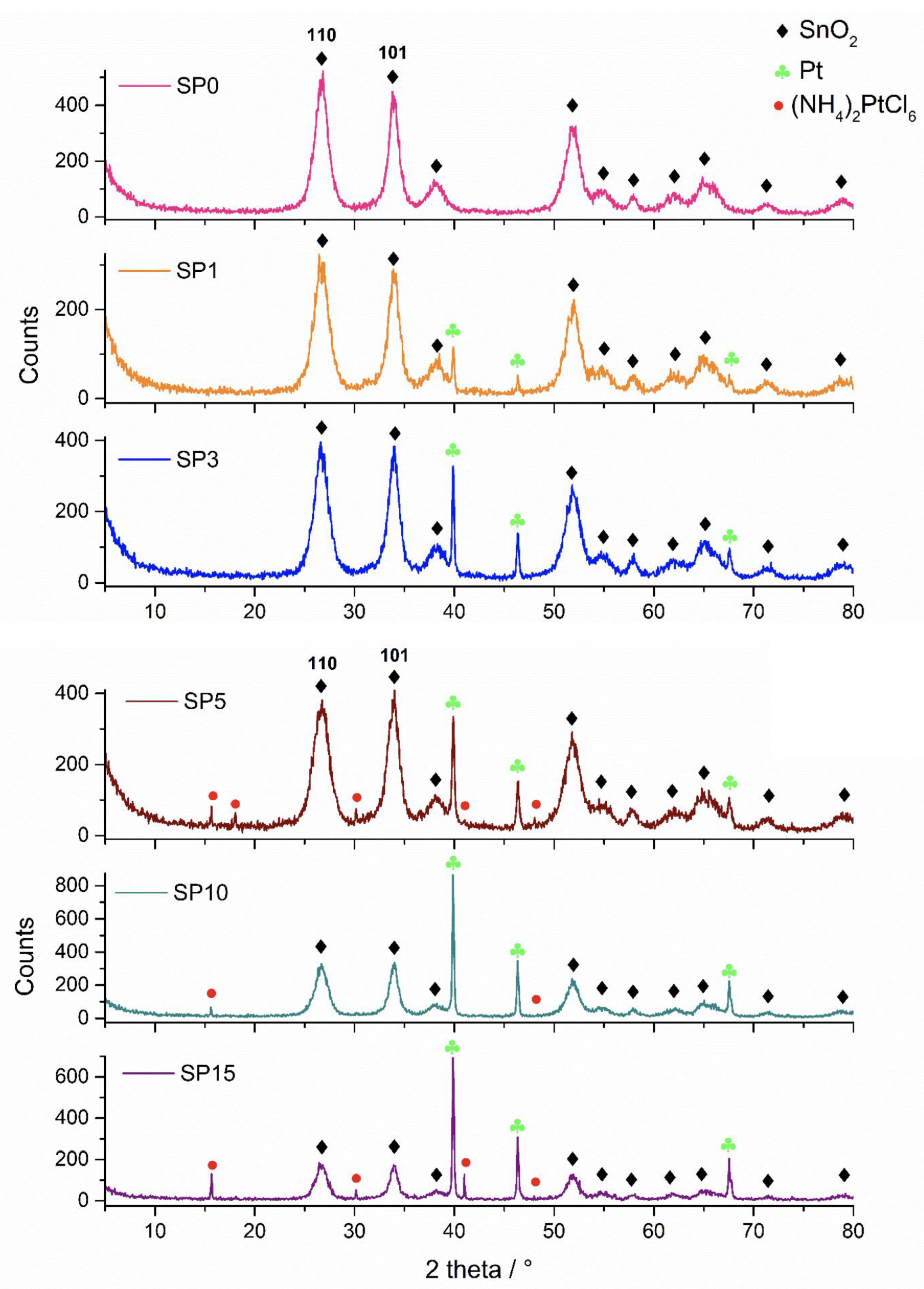

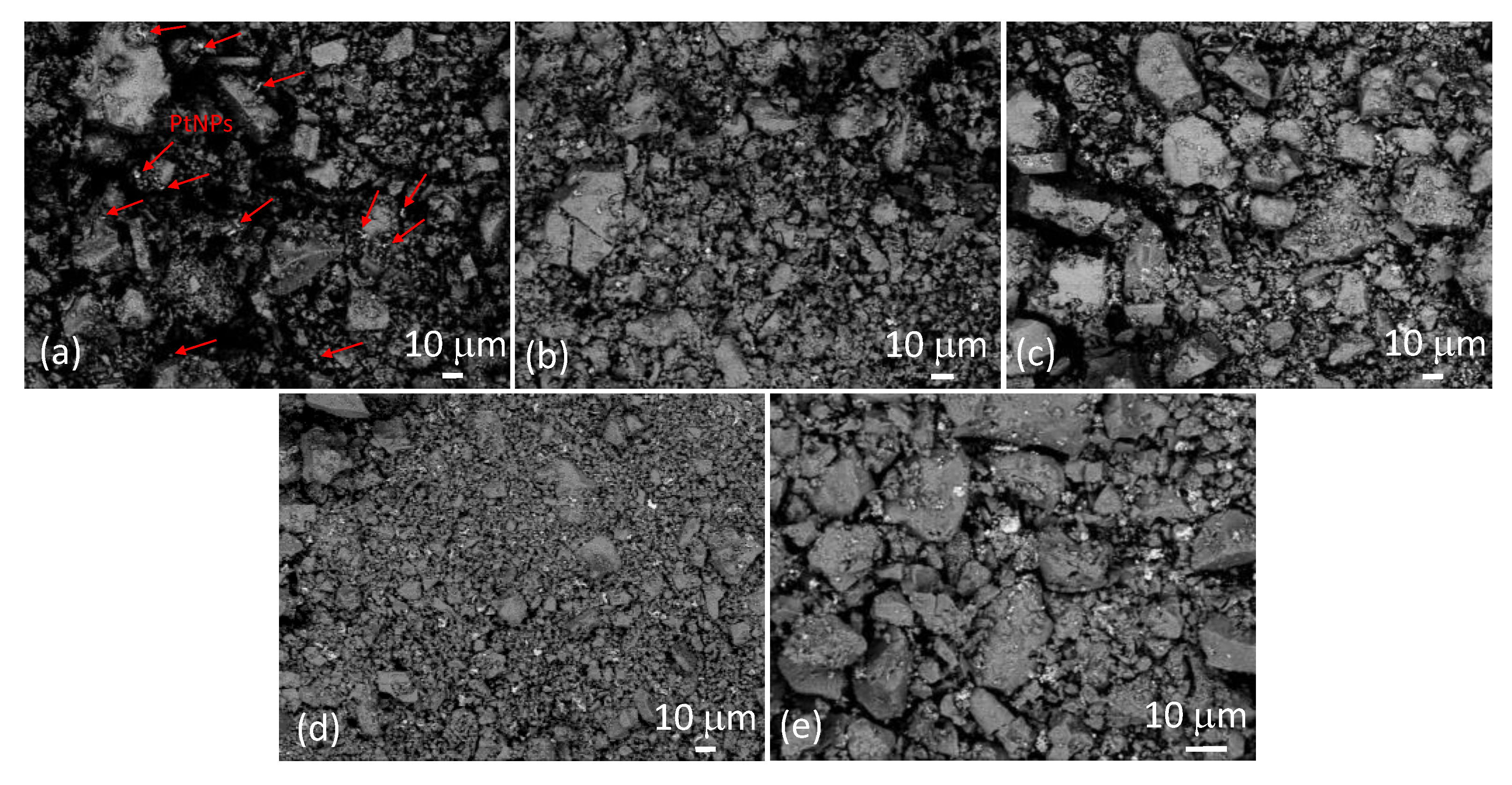
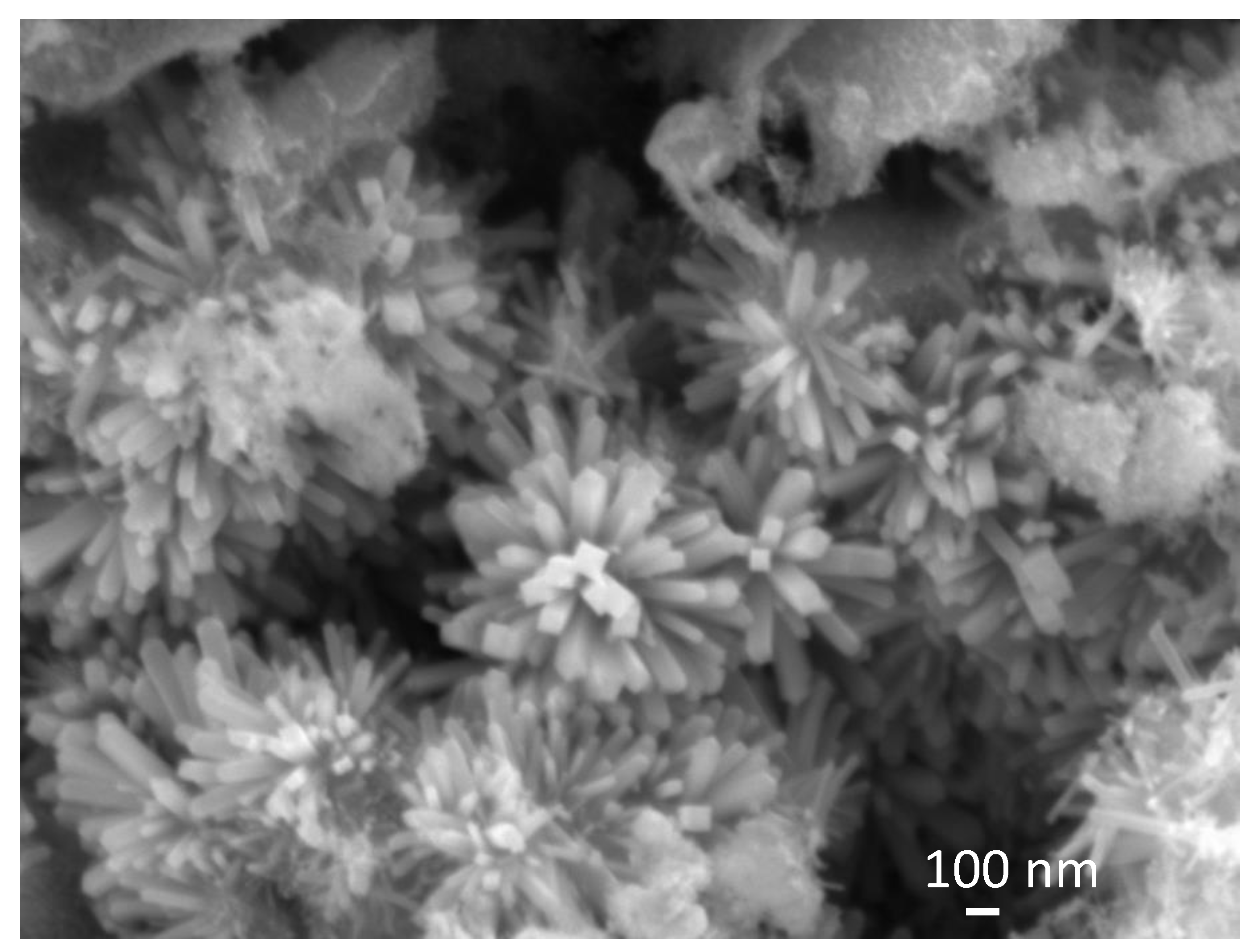

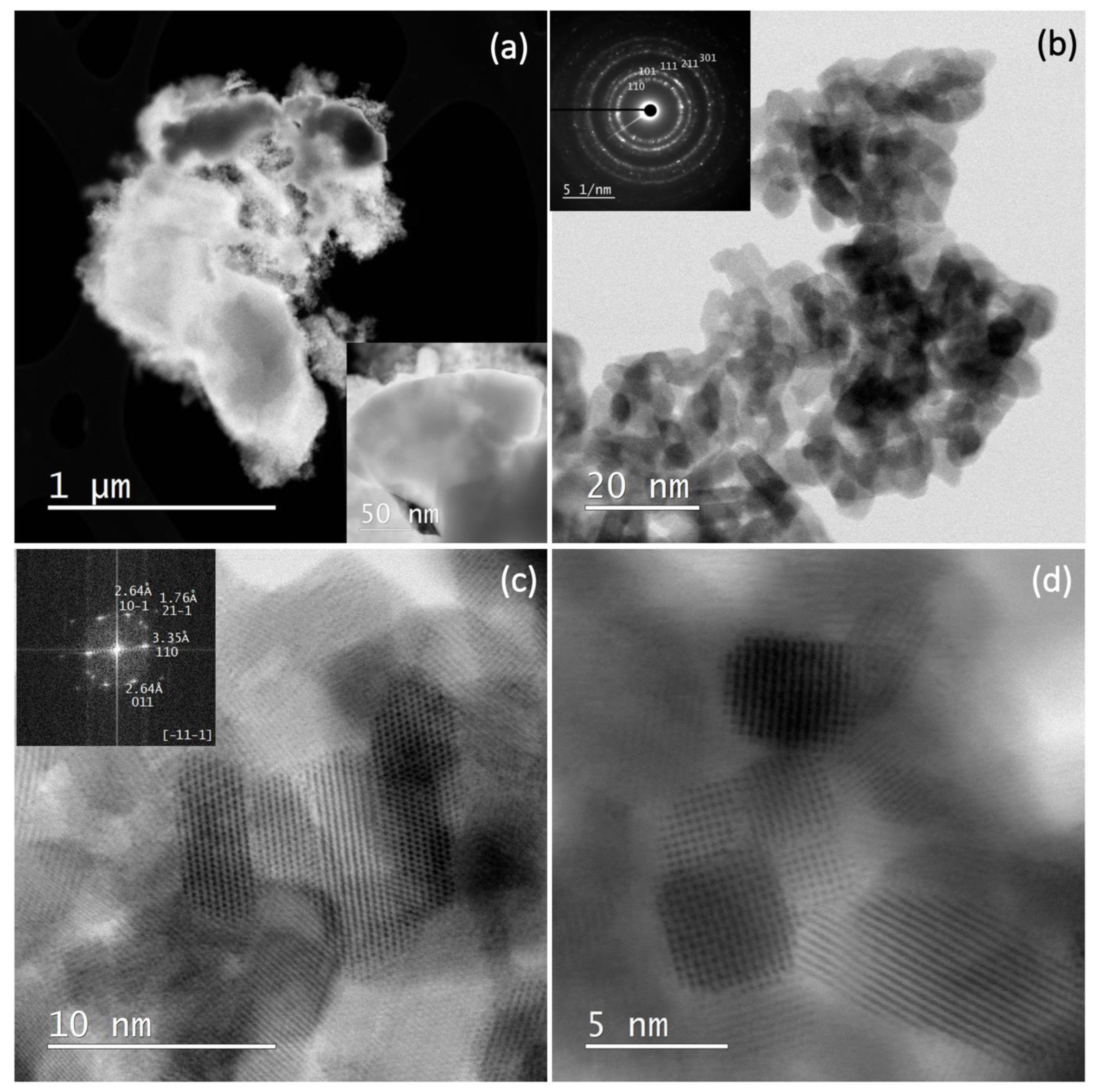
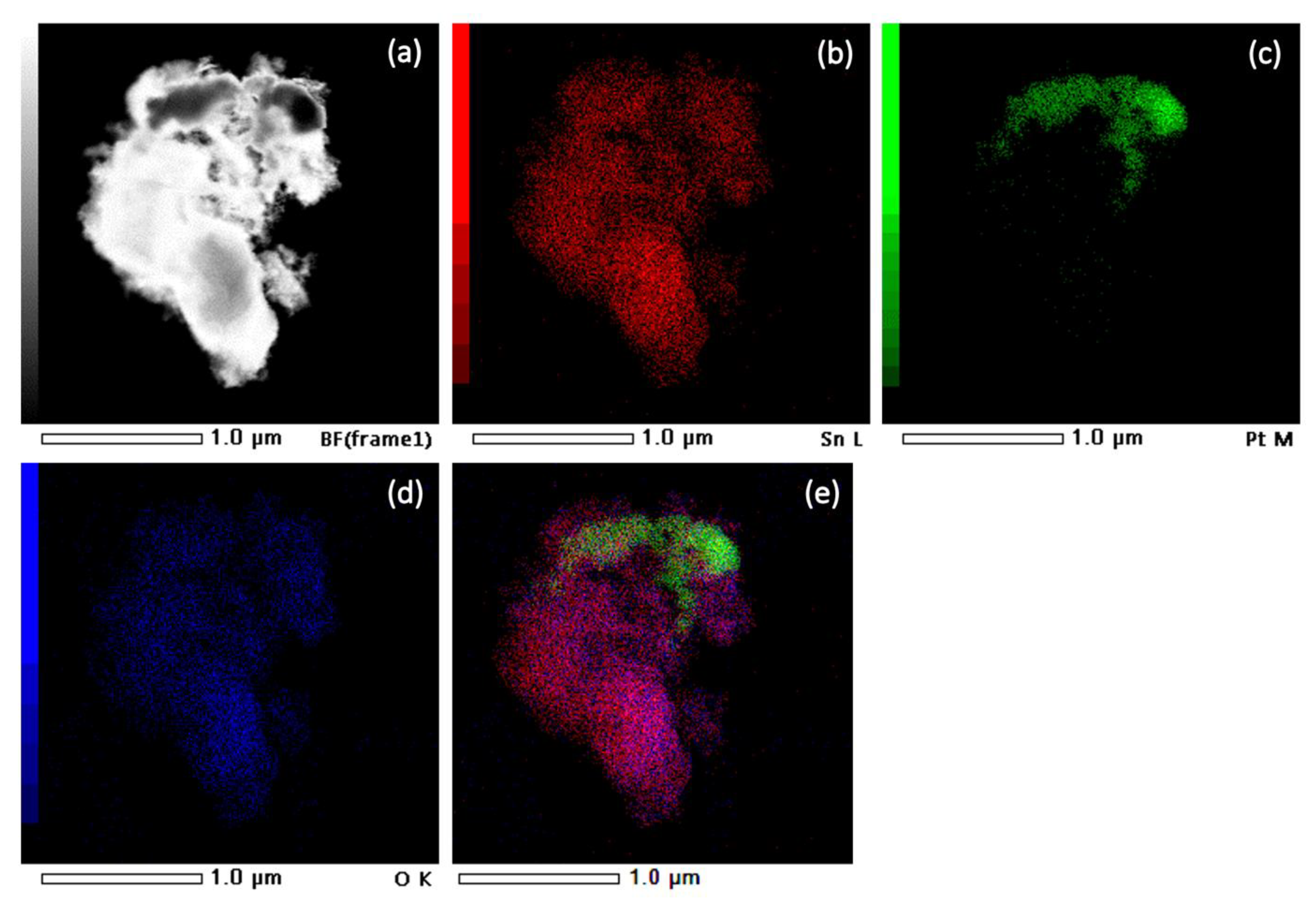
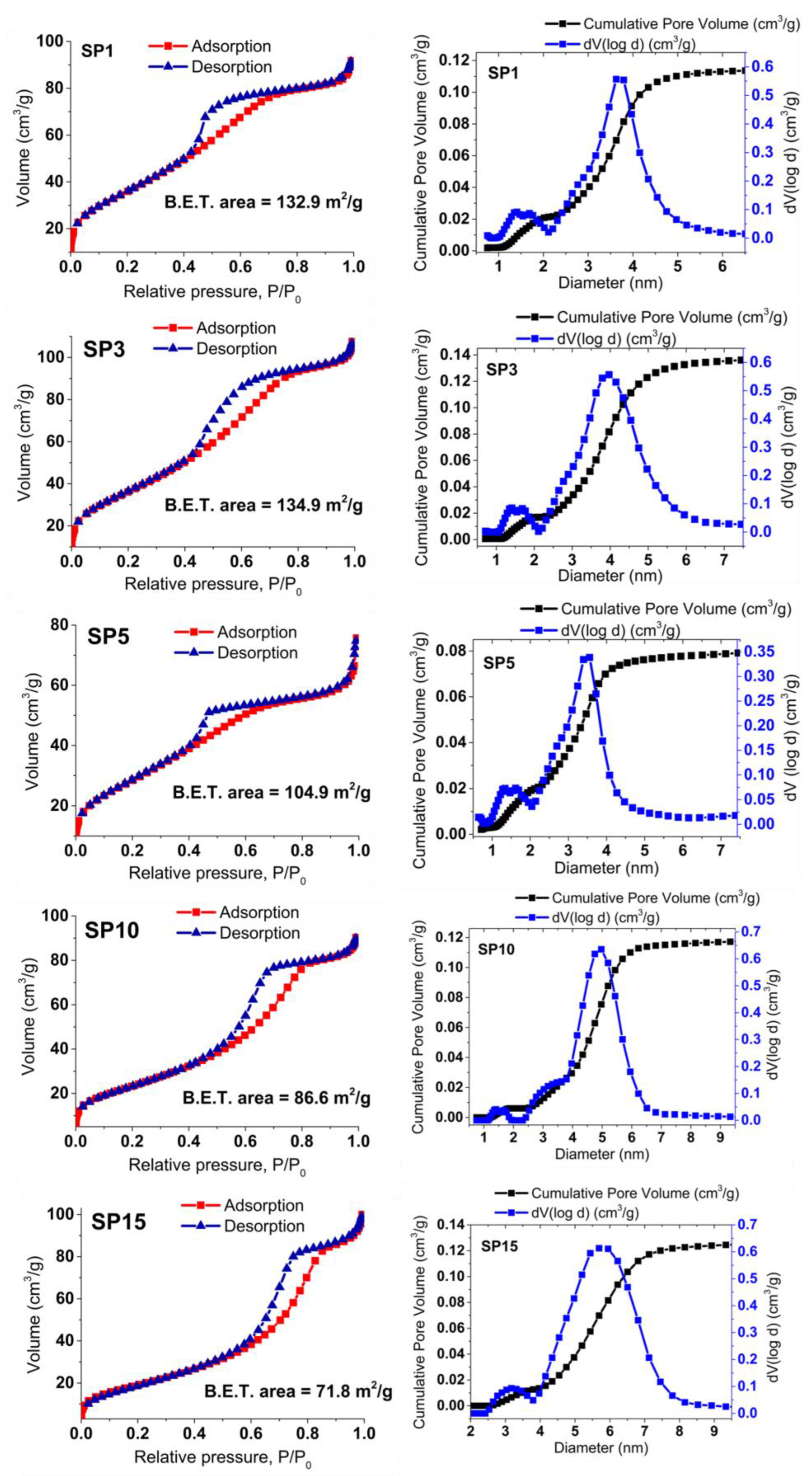
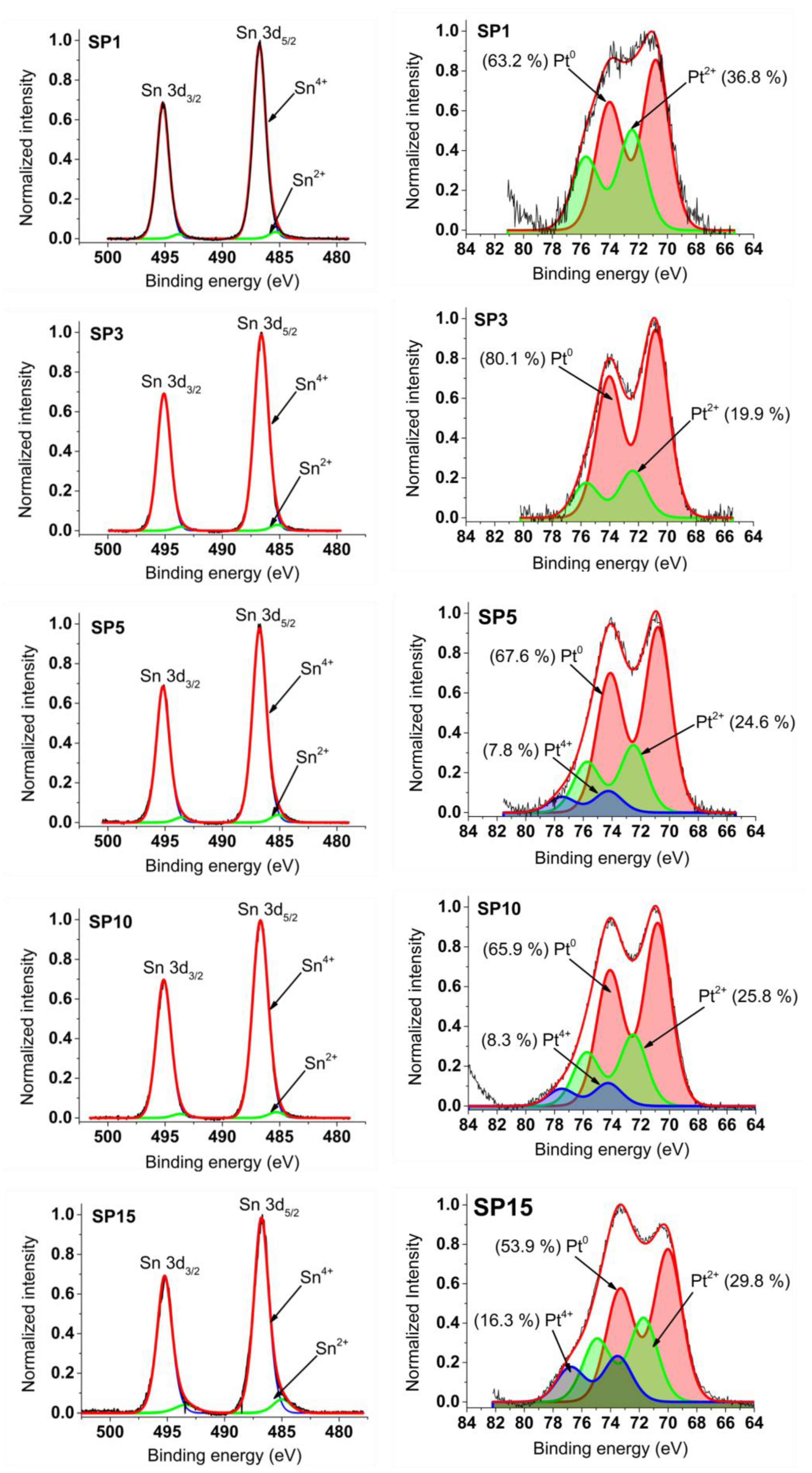
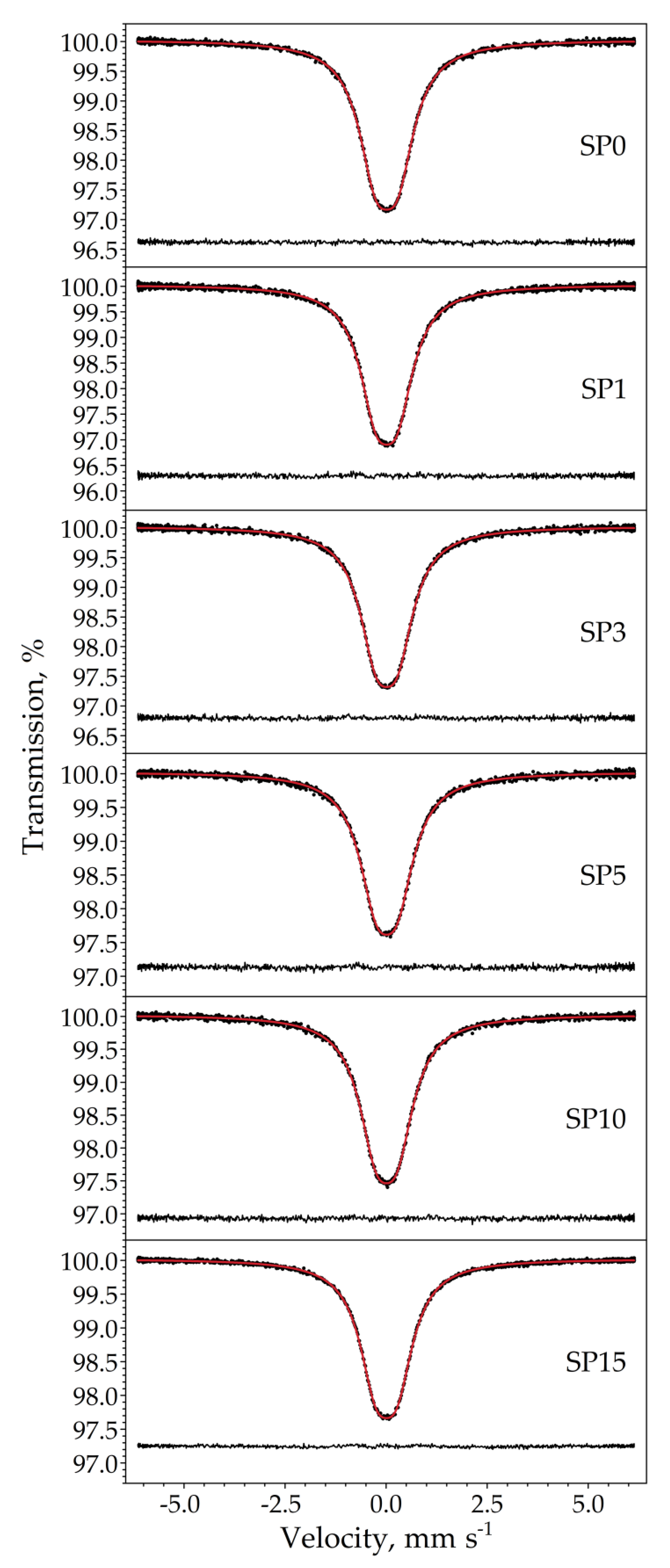



| Sample | V(SnCl4 Stock Solution)/mL | V(H2PtCl6 Stock Solution)/µL | [PtIV/(PtIV + SnIV)] |
|---|---|---|---|
| SP0 | 3.00 | 0 | 0.00 |
| SP1 | 2.97 | 30 | 0.01 |
| SP3 | 2.91 | 90 | 0.03 |
| SP5 | 2.85 | 150 | 0.05 |
| SP10 | 2.70 | 300 | 0.10 |
| SP15 | 2.55 | 450 | 0.15 |
| Sample | x (Pt) | Phase Composition |
|---|---|---|
| SP0 | 0 | SnO2 |
| SP1 | 0.01 | SnO2 + Pt |
| SP3 | 0.03 | SnO2 + Pt |
| SP5 | 0.05 | SnO2 + Pt + (NH4)2PtCl6 |
| SP10 | 0.10 | SnO2 + Pt + (NH4)2PtCl6 |
| SP15 | 0.15 | SnO2 + Pt + (NH4)2PtCl6 |
| Sample | Phase | h k l | 2θ/° | FWHM/° | Dhkl/nm |
|---|---|---|---|---|---|
| SP0 | SnO2 | 1 1 0 | 26.66 | 1.49 | 5.5(2) |
| 1 0 1 | 33.90 | 1.06 | 7.8(3) | ||
| 2 0 0 | 38.18 | 1.79 | 4.7(1) | ||
| 2 1 1 | 51.81 | 1.62 | 5.5(2) | ||
| 2 2 0 | 54.91 | 1.64 | 5.5(2) | ||
| 0 0 2 | 57.87 | 0.83 | 11.0(5) | ||
| 2 0 2 | 71.27 | 1.40 | 7.0(3) | ||
| SP1 | SnO2 | 1 1 0 | 26.65 | 1.69 | 4.8(1) |
| 1 0 1 | 33.91 | 1.21 | 6.9(2) | ||
| 2 0 0 | 38.21 | 1.91 | 4.4(1) | ||
| 2 1 1 | 51.83 | 1.59 | 5.6(2) | ||
| 2 2 0 | 54.88 | 1.71 | 5.2(2) | ||
| 0 0 2 | 57.85 | 0.89 | 10.2(4) | ||
| 2 0 2 | 71.30 | 1.23 | 8.0(3) | ||
| SP3 | SnO2 | 1 1 0 | 26.65 | 1.61 | 5.1(2) |
| 1 0 1 | 33.90 | 1.13 | 7.3(3) | ||
| 2 0 0 | 38.23 | 1.72 | 4.9(1) | ||
| 2 1 1 | 51.83 | 1.67 | 5.3(2) | ||
| 2 2 0 | 54.91 | 1.58 | 5.7(2) | ||
| 0 0 2 | 57.86 | 0.83 | 11.0(5) | ||
| 2 0 2 | 71.30 | 1.44 | 6.8(3) | ||
| SP5 | SnO2 | 1 1 0 | 26.64 | 1.76 | 4.6(1) |
| 1 0 1 | 33.86 | 1.26 | 6.6(2) | ||
| 2 0 0 | 38.16 | 1.77 | 4.7(1) | ||
| 2 1 1 | 51.81 | 1.76 | 5.0(2) | ||
| 2 2 0 | 54.88 | 1.71 | 5.2(2) | ||
| 0 0 2 | 57.82 | 0.89 | 10.2(5) | ||
| 2 0 2 | 71.23 | 1.34 | 7.3(3) | ||
| SP10 | SnO2 | 1 1 0 | 26.66 | 1.42 | 5.8(2) |
| 1 0 1 | 33.91 | 0.92 | 9.0(3) | ||
| 2 0 0 | 38.18 | 1.71 | 4.9(1) | ||
| 2 1 1 | 51.83 | 1.43 | 6.1(2) | ||
| 2 2 0 | 54.83 | 1.50 | 6.0(2) | ||
| 0 0 2 | 57.90 | 0.66 | 13.7(5) | ||
| 2 0 2 | 71.32 | 1.06 | 9.2(3) | ||
| SP15 | SnO2 | 1 1 0 | 26.66 | 1.29 | 6.3(2) |
| 1 0 1 | 33.90 | 0.81 | 10.2(4) | ||
| 2 0 0 | 38.21 | 1.65 | 5.1(1) | ||
| 2 1 1 | 51.81 | 1.24 | 7.1(3) | ||
| 2 2 0 | 54.77 | 1.35 | 6.6(2) | ||
| 0 0 2 | 57.83 | 0.75 | 12.1(5) | ||
| 2 0 2 | 71.34 | 0.93 | 10.5(4) |
| Sample | AOS of Pt (This Work) | AOS of Pt ii (Ref. [18]) | AOS of Sn (This Work) | AOS of Sn ii (Ref. [18]) |
|---|---|---|---|---|
| SP1 | 0.74 | 1.69 | 3.93 | 3.49 |
| SP3 | 0.40 | 1.69 | 3.94 | 3.22 |
| SP5 | 0.80 | 1.73 | 3.92 | 3.56 |
| SP10 | 0.85 | 2.11 | 3.94 | 3.50 |
| SP15 | 1.25 | - | 3.84 | - |
| Pt mol% | δ/mm s–1 | Δ/mm s–1 | W/mm s–1 |
|---|---|---|---|
| 0 | 0.0121(10) | 0.541(3) | 1.028(5) |
| 1 | 0.0121(11) | 0.520(4) | 1.008(5) |
| 3 | 0.0134(12) | 0.521(4) | 1.012(6) |
| 5 | 0.0116(13) | 0.518(5) | 1.043(6) |
| 10 | 0.0093(12) | 0.519(4) | 1.035(6) |
| 15 | 0.0070(7) | 0.516(2) | 1.005(3) |
Disclaimer/Publisher’s Note: The statements, opinions and data contained in all publications are solely those of the individual author(s) and contributor(s) and not of MDPI and/or the editor(s). MDPI and/or the editor(s) disclaim responsibility for any injury to people or property resulting from any ideas, methods, instructions or products referred to in the content. |
© 2023 by the authors. Licensee MDPI, Basel, Switzerland. This article is an open access article distributed under the terms and conditions of the Creative Commons Attribution (CC BY) license (https://creativecommons.org/licenses/by/4.0/).
Share and Cite
Đurasović, I.; Štefanić, G.; Dražić, G.; Peter, R.; Klencsár, Z.; Marciuš, M.; Jurkin, T.; Ivanda, M.; Stichleutner, S.; Gotić, M. Microwave-Assisted Synthesis of Pt/SnO2 for the Catalytic Reduction of 4-Nitrophenol to 4-Aminophenol. Nanomaterials 2023, 13, 2481. https://doi.org/10.3390/nano13172481
Đurasović I, Štefanić G, Dražić G, Peter R, Klencsár Z, Marciuš M, Jurkin T, Ivanda M, Stichleutner S, Gotić M. Microwave-Assisted Synthesis of Pt/SnO2 for the Catalytic Reduction of 4-Nitrophenol to 4-Aminophenol. Nanomaterials. 2023; 13(17):2481. https://doi.org/10.3390/nano13172481
Chicago/Turabian StyleĐurasović, Izabela, Goran Štefanić, Goran Dražić, Robert Peter, Zoltán Klencsár, Marijan Marciuš, Tanja Jurkin, Mile Ivanda, Sándor Stichleutner, and Marijan Gotić. 2023. "Microwave-Assisted Synthesis of Pt/SnO2 for the Catalytic Reduction of 4-Nitrophenol to 4-Aminophenol" Nanomaterials 13, no. 17: 2481. https://doi.org/10.3390/nano13172481
APA StyleĐurasović, I., Štefanić, G., Dražić, G., Peter, R., Klencsár, Z., Marciuš, M., Jurkin, T., Ivanda, M., Stichleutner, S., & Gotić, M. (2023). Microwave-Assisted Synthesis of Pt/SnO2 for the Catalytic Reduction of 4-Nitrophenol to 4-Aminophenol. Nanomaterials, 13(17), 2481. https://doi.org/10.3390/nano13172481









